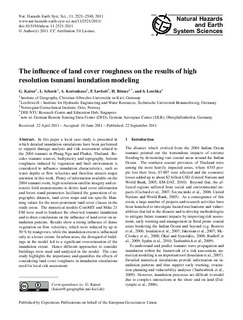| dc.contributor.author | Kaiser, Gunilla | |
| dc.contributor.author | Scheele, L.. | |
| dc.contributor.author | Kortenhaus, Andreas | |
| dc.contributor.author | Løvholt, Finn | |
| dc.contributor.author | Römer, Hannes | |
| dc.contributor.author | Leschka, Stefan | |
| dc.date.accessioned | 2016-01-27T15:16:22Z | |
| dc.date.accessioned | 2016-01-29T12:12:02Z | |
| dc.date.available | 2016-01-27T15:16:22Z | |
| dc.date.available | 2016-01-29T12:12:02Z | |
| dc.date.issued | 2011 | |
| dc.identifier.citation | Natural hazards and earth system sciences 2011, 11(9):2521-2540 | |
| dc.identifier.issn | 1684-9981 | |
| dc.identifier.uri | http://hdl.handle.net/11250/2375287 | |
| dc.description | - | |
| dc.description.abstract | In this paper a local case study is presented in which detailed inundation simulations have been performed to support damage analysis and risk assessment related to the 2004 tsunami in Phang Nga and Phuket, Thailand. Besides tsunami sources, bathymetry and topography, bottom roughness induced by vegetation and built environment is considered to influence inundation characteristics, such as water depths or flow velocities and therefore attracts major attention in this work. Plenty of information available on the 2004 tsunami event, high-resolution satellite imagery and extensive field measurements to derive land cover information and forest stand parameters facilitated the generation of topographic datasets, land cover maps and site-specific Manning values for the most prominent land cover classes in the study areas. The numerical models ComMIT and Mike 21 FM were used to hindcast the observed tsunami inundation and to draw conclusions on the influence of land cover on inundation patterns. Results show a strong influence of dense vegetation on flow velocities, which were reduced by up to 50% by mangroves, while the inundation extent is influenced only to a lesser extent. In urban areas, the disregard of buildings in the model led to a significant overestimation of the inundation extent. Hence different approaches to consider buildings were used and analyzed in the model. The case study highlights the importance and quantifies the effects of considering land cover roughness in inundation simulations used for local risk assessment. | |
| dc.language.iso | eng | |
| dc.title | The influence of land cover roughness on the results of high resolution tsunami inundation modeling | |
| dc.type | Journal article | |
| dc.date.updated | 2016-01-27T15:16:22Z | |
| dc.subject.nsi | VDP::Matematikk og naturvitenskap: 400::Geofag: 450::Naturgeografi: 455 | |
| dc.subject.nsi | VDP::Mathematics and natural scienses: 400::Geosciences: 450::Physical geography: 455 | |
| dc.identifier.doi | 10.5194/nhess-11-2521-2011 | |
| dc.identifier.cristin | 884332 | |
| dc.subject.keyword | Flodbølger / Flood waves | |
| dc.subject.keyword | Tsunami / Tsunami | |
